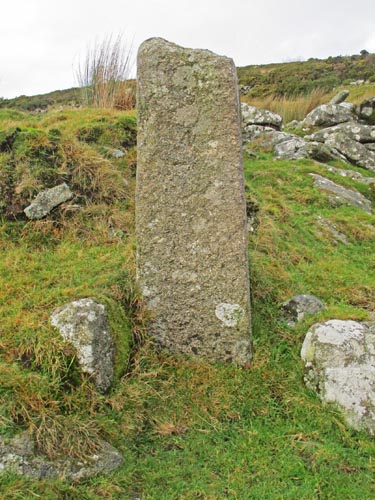| Crazywell Farm Cross |
 Location:
The northernmost of two
gate posts, 15 yards to the west of the Crazywell Farmhouse. Location:
The northernmost of two
gate posts, 15 yards to the west of the Crazywell Farmhouse.O/S Grid Ref: SX/58086/70057 Longitude/Latitude (Degrees+/-): -4.00294/50.51305 Map location: Click here to view map. Purpose: Most probably it was originally a waymarker for a local track across the moor, possibly the Monk's Path. Size: The cross shaft measures 3 feet 2 inches (0.97 metres) high, 12 inches (0.31 metres) wide and 10 inches (0.25 metres) in depth. Information: This
stone, which has a slight taper, is in position as the northernmost of two gateposts to a field
leading in to the, now abandoned, Crazywell Farm. Although it
is a well-worked stone, we are not absolutely sure whether it was a cross
shaft, a door or window lintel or, possibly, a If it is, indeed, a cross shaft, it is not known where the cross would originally have stood but, as it is quite close to the route of the Monk's Path, which is the ancient name given to the track that links the Buckfast Abbey with those at Tavistock and Buckland, it would quite likely have been a waymarker for that route. This would link in with the two other nearby crosses, Crazywell and Newleycombe, which were also waymarkers for the Monk's Path. There is, of course, the possibility that this was the original shaft of the Crazywell shaft which, with the head removed, was put to another purpose at the farm. A small hole, 1¼ inches (32 mm) in diameter and 1 inch (25 mm) deep, has been drilled into the top of the stone. Although the purpose of this hole is unknown, it has been suggested that it could have been used in connection with attaching the cross head to the top of the shaft. The south-facing Crazywell Farm is situated just
below the bridleway which runs from Peat Cot/Nun's Cross to Leather
Tor Bridge. It is currently hidden from the track by a row of gorse,
but it is well worth the effort of finding a way through the gorse to seek
the farm out. The walls of the farmhouse are now quite low to the
ground, but there is a nice granite lintel still in place over the
entrance doorway. The building was originally a medieval longhouse,
measuring 28½ feet long by 12½ feet wide. There are also a few Within the confines of the farmyard
there is a stone which is believed to be an unfinished quern. The
stone has a hole drilled into the top but it appears as though when the
mason tried to widen the diameter of the hole, a large piece of the stone
broke away from the face making it unfit to continue and it was abandoned.
A quern was a stone with a wide, but shallow, hole or dip in the upper
surface into which would be put some grain
and where a second stone would be used grind the grain down into flour.
This would only have Further to the west, there are two fine examples of a sheep creep set into the base of the boundary wall. These are low square openings in the wall which were big enough to allow sheep to pass through, but small enough to prevent larger animals, like cows, from leaving the field. Our thanks to Bob Noakes and Nigel Machin for bringing this cross to our attention. |